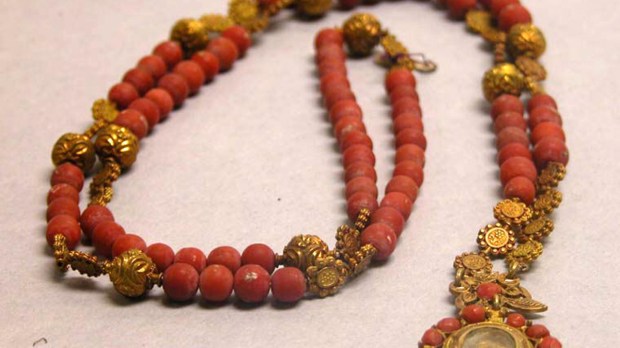Environmental concerns mean that coral is now equated with the word endangered. The significance of coral used to be quite different. With the month of the Most Precious Blood coming up, what better medium could there be to represent Christ’s blood? Rubies and garnets would also work admirably, but they are even harder to procure and carve.
The sacred symbolism of coral
Finding references to coral in the Bible is problematic. Early translations were quite loose when it came to precious objects. Gemology was a very young science in those days. It seems that the distinction between pearls and coral was especially vague. Both are part of living organisms found in the sea. That was enough for the pioneer scientists of the past.
If we turn away from the Bible and look at actual usage, there is an abundance of coral to behold. Pink or red have been the most popular colors, transformed into countless items of Catholic significance. Celebration of the Most Precious Blood is comparatively recent when viewed against the general veneration of Our Lord’s bodily suffering. Coral has much in common with the regenerative power of the crucifixion. This living organism dies and then leaves a foundation on which other coral can build their lives.
In classical antiquity, coral was seen as many things. Providing a connection with the crucifixion that would come later, it was described as a “tree of blood.” With less of a Christian connection it was also called “Medusa’s hair.”
Wherever it has gone around the world, coral has been treated reverentially and with more than a dash of positive superstition. Its sanctity peaked during the Counter Reformation period in Europe. At a time when the Catholic Church was encouraging the veneration of sacred images, coral’s symbolism came into its own.
Coral rosaries and crucifixes
Sicily had a long reputation for gathering and working the sea’s bounty, and the city of Trapani became a centre for producing works in coral. Rosary beads were among the most popular exports from an island that was more central to world trade 400 years ago than it has been in the past century. Combined with gilded metal, coral could be used for tiny crucifixes or crowns of thorns to much larger shrines. It looked like both the blood of Christ and His tears. It was the perfect, colorful antidote to the drabness of the Protestant Reformation.
The allure of coral faded as ivory became more available, although it is still used today to a much smaller extent for religious items in Italy. It remains astonishing in many ways. Soft when submerged and extremely hard when dried, coral is almost miraculous. Those who don’t know it grows in the sea are hardly ever able to guess its origins. Just as unusual is the way that it started life in the Mediterranean and then spread eastwards to China and westwards to the Americas. Most natural wonders have traveled in the opposite direction.
Not all of the sacred coral served the purpose for which it was intended. Of the many coral rosaries taken to North America by Spanish missionaries, it seems that beads were sometimes repurposed for secular necklaces by the Native American recipients.
Endangered commodity
Nowadays, there’s a certain reticence about coral. As with elephants and their ivory, excessive harvesting has threatened the species with extinction. In the past, both of these materials were more renewable because the market was so much smaller. They tended to be beyond the means of non-royal consumers.
In the 21st century there are far fewer jewelers who will use new coral. Recycling vintage items is their concession to environmental concerns. As most of the old Catholic items are much-loved heirlooms or in museums, it’s unlikely that they will be transformed into a New Age healing bracelet or yin-yang pendant.

